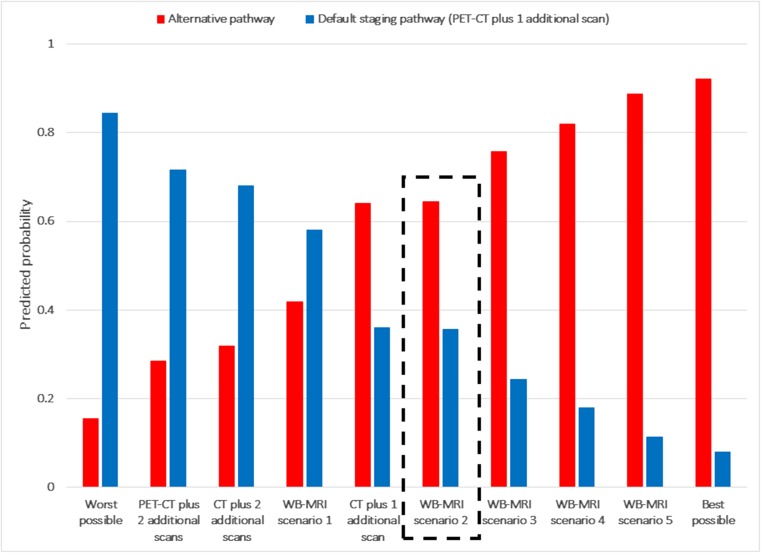Fig. 3.
Predicted probabilities of choosing an alternate staging pathways in comparison to a default staging pathway (PET-CT plus one additional scan) (lung cancer patients). Description of tests: Default staging pathway (PET-CT plus 1 additional scan) in every case: 30-min time in a scanner, 3 weeks to diagnosis, 2/1000 cancer risk due to radiation dose, 1 additional scan, 90% accuracy, no need for whole body and head to be in a scanner. Worst possible test: 60-min time in a scanner, 5 weeks to diagnosis, 2/1000 cancer risk due to radiation dose, 2 additional scans, 85% accuracy, need for whole body and head to be in a scanner. PET-CT plus 2 additional scans: 30-min time in a scanner, 5 weeks to diagnosis, 2/1000 cancer risk due to radiation dose, 2 additional scans, 90% accuracy, no need for whole body and head to be in a scanner. CT plus 2 additional scans: 10-min time in a scanner, 5 weeks to diagnosis, 2/1000 cancer risk due to radiation dose, 2 additional scans, 90% accuracy, no need for whole body and head to be in a scanner. WB-MRI scenario 1: longer scan time, no radiation, whole body enclosed, longer time to diagnosis, more scans = 60-min time in a scanner, 5 weeks to diagnosis, 0/1000 cancer risk due to radiation dose, 2 additional scans, 90% accuracy, need for whole body and head to be in a scanner. CT plus 1 additional scan: 10 min time in a scanner, 3 weeks to diagnosis, 1/1000 cancer risk due to radiation dose, 1 additional scan, 90% accuracy, no need for whole body and head to be in a scanner. WB-MRI scenario 2: longer scan time, no radiation, whole body enclosed = 60-min time in a scanner, 3 weeks to diagnosis, 0/1000 cancer risk due to radiation dose, 1 additional scan, 90% accuracy, need for whole body and head to be in a scanner. WB-MRI scenario 3: longer scan time, no radiation, whole body enclosed, more accurate = 60-min time in a scanner, 3 weeks to diagnosis, 0/1000 cancer risk due to radiation dose, 1 additional scan, 95% accuracy, need for whole body and head to be in a scanner. WB-MRI scenario 4: longer scan time, no radiation, whole body enclosed, quicker time to diagnosis, fewer scans = 60-min time in a scanner, 1 week to diagnosis, 0/1000 cancer risk due to radiation dose, 0 additional scans, 90% accuracy, need for whole body and head to be in a scanner. WB-MRI scenario 5: longer scan time, no radiation, whole body enclosed, more accurate, quicker time to diagnosis, fewer scans = 60-min time in a scanner, 1 week to diagnosis, 0/1000 cancer risk due to radiation dose, 0 additional scans, 95% accuracy, need for whole body and head to be in a scanner. Best possible pathway: 10-min time in a scanner, 1 week to diagnosis, 0/1000 cancer risk due to radiation dose, 0 additional scans, 95% accuracy, no need for whole body and head to be in a scanner. The comparison indicated by the dashed box (WB-MRI scenario 2) is one in which WB-MRI differs from the default staging pathway according to established differences (time in a scanner, exposure to ionising radiation, need for the whole body and head to be inside the scanner) but for which other attributes (time to diagnosis, number of additional scans, accuracy) are assumed to be the same between the two pathways

